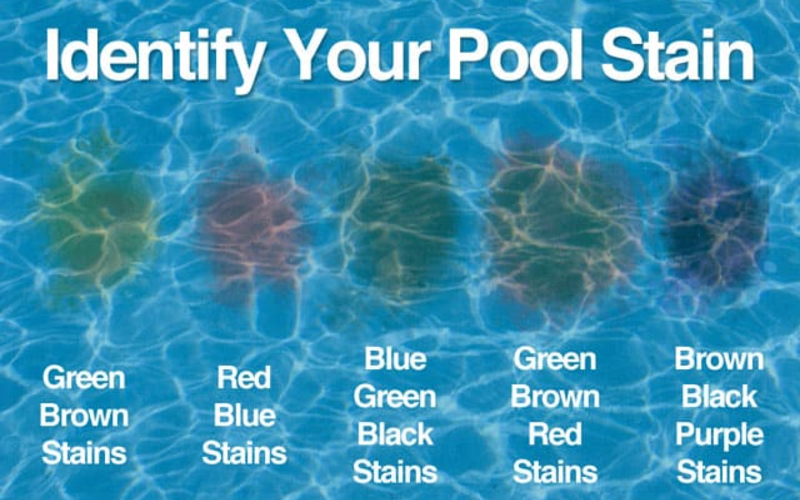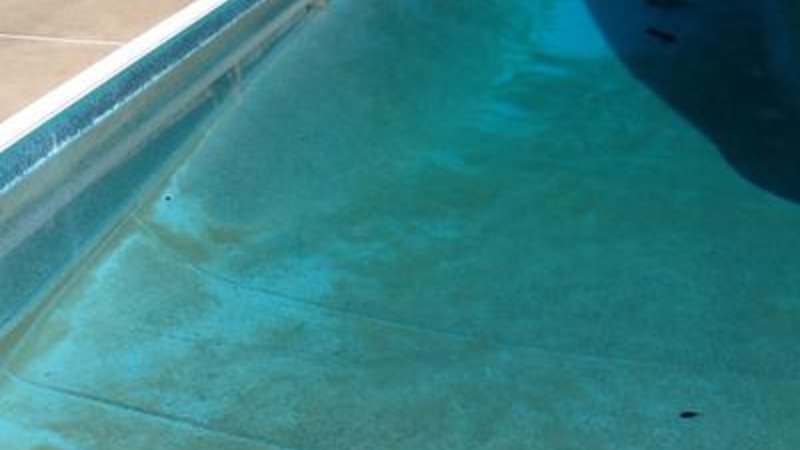- Home
- Troubleshooting
- Pool Stains
How to Identify and Remove Pool Stains
Having a clean pool is what we want. A dirty pool is a no-no. And what happens when your pool is stained? You're probably asking yourself how it happened. You're doing everything correctly. You're vacuuming and cleaning. You're balancing your chemicals twice per week. What's going on?
Then the follow up question is how do I get rid of it? You can do everything right and still end up with a pool stain. The good news is you can identify it and then get rid of it. But we need to know what caused the stain in the first place.
What's Causes Pool Stains?
Sometimes it's difficult to determine the cause of the pool stain and there could be several contributing factors. That being said, we're still in luck. Pool stains generally fall into 3 categories and they are:
- Organic: Things such as leaves, grass, sticks, pinecones, and berries that fall from trees.
- Metal: This could be an overdose of copper algaecide, nails, screws, well water, or corroded metal pipes.
- Chemical: This would include adding liquid chlorine to the shallow end and not sweeping, chlorine tabs tossed into the pool, or muriatic acid settling to the bottom. Once you've determined the type of pool stain you have, you can apply the right type of pool stain remover.
How To Identify Pool Stains
You can easily identify pool stains by their colors. You can use the chart below to see what color stain you have.

Green Brown Stains
These are the most common and can be attributed to organic matter such as grass, leaves, and sticks.
Red Blue Stains
These pool stains normally come from berries that fall from a nearby tree.
Blue Green Black Stain
These pool stains could be a combination of organic matter such as grass and leaves, and metals such as well water or an overdose of algaecide.
Green Brown Red Stains
These are normally reserved for metals such as iron that's found in well water.
Brown Black Purple Stains
This color combination is caused by manganese and is a naturally occurring metal in well water. Manganese can also be found in municipal water supplies.
How To Determine What Caused The Pool Stain
I always say when it doubt, test it out. We should run some very simples tests to determine the cause of the stain. Once we're pointed in the right direction, the fun starts with testing the pool stains.
Organic Stain Test
This is a very simple test, and the easiest of all. Grab an old sock, fill it with calcium hypochlorite, and place it on a your pool stain. Let it sit for a few minutes, then remove the sock. If the stain lightens up, it's an organic stain.
Metal Stain Test
This stain test requires you to get something you might already have on hand. Good old fashioned Vitamin C, known in the pool industry as ascorbic acid. Crush up your Vitamin C tablets, put that in the other sock, and place it on an affected area. If the stain lightens up after an hour or so, you have a metal stain.
Chemical Stain Test
Unfortunately, there's really no remedy for chemical pool stains. It's like spilling bleach on your jeans. Once it stains, there's really no going back. Best thing we can do is sweep after adding chemicals so they don't settle to the bottom. And let's use our chlorine tablet feeder or our tablet float. Never toss chlorine tabs in the pool. They'll sink to the bottom and stain your beautiful pool.

Let's Get The Pool Stains Out
So we've identified the pool stains. Great. Now comes the work of removing it for good.
How To Remove Organic Pool Stains
Organic pool stains worst enemy is chlorine. I mean high doses of chlorine. So here's what we'll do.
- Test and balance the water: Make sure our pH is at 7.0 - 7.2. Chlorine works much better at a lower pH level. Our alkalinity should be between 80 - 120 ppm. I use and recommend the Taylor K-2006 pool test kit.
- Properly shock the pool: You'll want to bring your chlorine level up to about 15 ppm. If you have a much larger stained area, you will want to maintain that level for a couple of days. Shocking your pool in the evening will give the chlorine the best chance for success.
- Brush the pool: Use a nylon brush on fiberglass and vinyl pools. For plaster or concrete, you can use a wire brush.
- Filter: Make sure you keep that pump motor on and allow all the chemicals to go through the entire system.
- Brush the pool again: Lots of brushing going on here, but that's what it takes to remove your pool stains. Scrub all affected areas very well.
Are the stains gone? Great!! If not, or if they've lightened up, which they should have, repeat the process over again until the stain has finally disappeared.
How To Get Rid Of Metal Pool Stains
Metal pool stains can be a little tricky, so be mindful and take care how your approach a metal stain in your pool.
- Get your water tested for metals: You can easily take a sample of water to your local pool store for analysis or purchase an inexpensive kit to test for metals in your pool water. If you suspect your water has metals and you're on city water, simply call your water company and ask if metals were present the last time they tested the water.
- Choose a metal stain remover: Choose a stain remover that is specifically designed for your pool metal stain. Always follow the manufacture's instructions. For smaller areas, ascorbic acid in a sock also works.
How To Prevent Pool Stains
An ounce of prevention is worth a pound of cure. Knowing how to prevent pool stains might be more important than removing them.
How To Prevent Organic Pool Stains
A little time, effort, and knowledge can go a very long way.
- Keep your pool water balanced at all times.
- Test your chemicals twice per week, especially the pH and chlorine.
- Vacuum your pool when needed, or at least once per week.
- Remove and skim debris out of your pool. Keep an eye on material that settles to the bottom and immediately remove it.
- Keep your trees trimmed and bushes cut back.
- Pick up any leaves that fall on the ground. Pools are a magnet for debris. Just because it's not in your pool now doesn't mean it might not make its way into your pool later on.
- If you're thinking about landscaping around your pool, consider non-fruit bearing trees and non-flowering plants.
- Check the pool on a regular basis for stains.
How To Prevent Metal Pool Stains
This one takes a little more effort, but you can do it.
- Only use a PolyQuat 60 algaecide
- Test your pool water for metals and use a metal sequestrant if the tests come back positive. Jack's Magic and ProTeam metal Magic work very well. Dose your pool as needed.
- Maintain a constant pH if you have any metal or copper plumbing
How To Prevent Chemical Pool Stains
Chemical stains in your pool are much more difficult to remove. For that, there are pool stain preventative measures you can take.
- Only add chemicals to the deep end.
- Sweep well after adding chemicals, especially chlorine and acid.
- If you must add many chemicals, such as clearing up a green pool, add 1 gallon of chlorine, sweep well, then add another gallon and sweep.
- Use a chlorine tablet feeder or tab float. Never toss tabs directly into the pool.
Final Thought On Pool Stains
Pool stains can be a pain, but not to worry. You now know how to identify stains in your pool and the best method to get rid of them. And that knowledge is worth its weight in gold.

